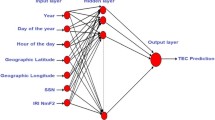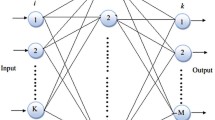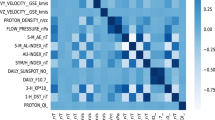Abstract
The atmosphere is exposed to the Sun–Earth interaction. The ionosphere is located in the upper part of the atmosphere, extending from 50 to 1000 km, and where the signal transfer is addressed. It is the layer where the changes resulting from this interaction are observed. Total electron content (TEC) is a dynamic and vital ionospheric variable that enables the understanding and interpretation of ionospheric changes. This study models Global Navigation Satellite System (GNSS)-based TEC data with an artificial neural network for the solar wind parameters during a moderate (February 02, 2015) and a weak (February 07, 2015) geomagnetic storm. Physical facts and the causality principle govern these models. The conclusions agree with the literature and are acceptable. The performance of the models is evaluated by the correlation coefficient (R), mean square error, and absolute mean error. The R for the TEC data of the moderate GS (Dst = – 55 nT) is 0.969, and the mean square error is 3.742. In addition to these values, the absolute mean error is 0.53% with a variance of 0.06. The R for the TEC data of the weak (Dst = – 44 nT) GS is 0.988, the mean square error value is 2.050, and the absolute mean error is 0.41% with a variance of 0.03. These results seem acceptable and comparable for both geomagnetic storms.








Similar content being viewed by others
References
H S Fu et al (2017) Geophys Res Let. 4 37 (2017)
E Eroglu New Astronomy 60 33 (2018)
E Eroglu Math Prob Eng 2022 9592008 (2022)
K Koklu Adv Space Res 66 932 (2020)
K Koklu Math Probl Eng 2021 9948745 (2021)
K Koklu Adv Space Res 70 2929 (2022)
F Basciftci Indian J Phys. 96 2707 (2022)
E Astafyeva and I Zakharenkova M Forster JGR Space Phys 120 9023 (2015).
S Schaer, W Gurtner and Feltens, J. IONEX: The ionosphere map exchange format version 1, in: proceedings of the 1998 (IGS Analysis Centers Workshop) 9–11 February p 233 (1998)
S Schaer PhD Thesis (Universitat Bern) (1999)
D Bilitza et al Space Weather 15 418 (2017)
R Dach et al Bernese GNSS Software Version 5.2 (Switzerland) Astronomical Institute, University of Bern (2015).
E Senturk Geophys. 38 1031 (2020).
M H Rees Physics and chemistry of the upper atmosphere (Cambridge University Press) (1989)
E Tulunay et al Radio Sci. 41 1 (2006)
S Inyurt Geophys. 35 817 (2017).
K Ansari, O Corumluoglu and S K Panda Astrophys Space Sci 362 65 (2017).
K Ansari, O Corumluoglu and P Verma Surv Rev 50 412 (2018)
F Basciftci et al Int J Eng Geosci 3 61 (2018)
F Basciftci Geomagn. Aeron. 61 S156 (2021)
A Tebabal et al J. Atmos. Sol.-Terr. Phys. 172 143 (2018)
R Atici, A Aytas and S Sagir Adv Space Res 65 2158 (2020).
O V Mandrikova, V V Geppener and B S Mandrikova J Phys: Conf Ser 1368 052026 (2019).
J L Elman Cognitive Science 14 179 (1990)
S Inyurt and A Sekertekin Astrophysics and Space Science 364 62 (2019).
G Razin and M R B Voosoghi GPS Solut 24 51 (2020).
R K Mishra et al Radio Science 55 (2020)
O Isik and Z F Kocak E Eroglu Applications & Applied Mathematics 9 637 (2014).
D E Rumelhart and G E Hinton R J Williams Nature 323 533 (1986).
L V Fausett Fundamentals of Neural Networks: Architecture, Algorithms and Applications. Prentice-Hall, Inc, Englewood Cliffs, NJ (1994)
H S Stern Technometrics 38 205 (1996)
A G El-Din and D W Smith Water Research 36 1115 (2002).
R P Lippmann ASSP Magazine, IEEE 4 4 (1987)
Acknowledgements
The authors thank to NASA and Kyoto University. The authors thank to Center for Orbit Determination in Europe (CODE). Research of E. Nane is partially supported by a Simons Foundation Collaboration Grant for Mathematicians.
Author information
Authors and Affiliations
Corresponding author
Ethics declarations
Conflict of interest
The authors declare that there are no conflicts of interest.
Additional information
Publisher's Note
Springer Nature remains neutral with regard to jurisdictional claims in published maps and institutional affiliations.
Rights and permissions
Springer Nature or its licensor (e.g. a society or other partner) holds exclusive rights to this article under a publishing agreement with the author(s) or other rightsholder(s); author self-archiving of the accepted manuscript version of this article is solely governed by the terms of such publishing agreement and applicable law.
About this article
Cite this article
Eroglu, E., Nane, E. GNSS-based TEC data modeling with the solar wind parameters. Indian J Phys 97, 1973–1980 (2023). https://doi.org/10.1007/s12648-022-02573-z
Received:
Accepted:
Published:
Issue Date:
DOI: https://doi.org/10.1007/s12648-022-02573-z




